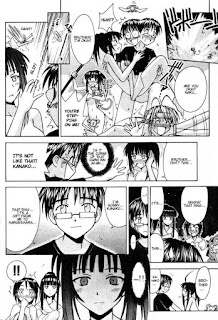I've already written a long summation of the LOVE HINA manga here, and so will write this essay as if the reader has already acquainted himself with the basics.
More often than not, manga-serials are written with a definite conclusion in the author's mind. This doesn't mean that every story that has a well-conceived ending necessarily has "unity of action." Still. I did regard the completed story of HELLSING to comprise one big myth, and though DANCE IN THE VAMPIRE BUND is still a "work in progress," I judged that the most recent addition to its storyline suggests the high amplitude of a mythcomic.
LOVE HINA ends with the culmination of the romance between young lovers Keitaro and Naru. However, the stories leading up to that culmination are much more episodic in nature than, say, those of HELLSING, or even another comedy-romance like BECAUSE I'M THE GODDESS. Author Ken Akamatsu breaks up the forward progress of his main plot with countless wacky escapades, sometimes for the purpose of expanding on character-traits, and sometimes just for fun. Thus LOVE HINA as a whole does not meet the mythcomics test. However, I've analyzed one particular episode, SECRET OF THE MYSTERIOUS GIRL, as a story that shows high mythicity. The same principle applies to one of Akamatsu's more cohesive arcs, which I've titled "Sister Syndrome" after one of the story-titles used in the Tokyopop English translation.
If the underthought of LOVE HINA could be boiled down to a binary statement, it might read something like, "The lover who is not the guy's sister triumphs over those who are almost-sisters." Of all the women in Keitaro Urashima's "harem," Naru has the least resemblance to a sibling, and so from one point of view, she would seem to be the best possible mate for Keitaro. "Sister Syndrome," however, deals with one of the greatest threats to Naru's romantic hegemony-- Kanako, who has formed a passion for her adoptive brother Keitaro. She appears in the previous arc, showing up at Hinata House at a time when Keitaro is away studying archaeology, and she uses the Urashima name to take control of the dormitory and force everyone to obey her whims. Even before Keitaro returns, Kanako regards Naru as her primary rival, while for her part, Naru;s insecurities are brought out by the prospect of meeting a female with a more profound connection to Keitaro-- that of family-- than she Naru has.
Volume 12 begins with Keitaro returning to the dormitory. At this time he has confessed his romantic devotion to Naru, but she has not made a full reciprocation, due to her ongoing insecurities. When he first sees Kanako, he doesn't recognize her as his adoptive sister, since he hasn't seen her in years.
For her part Kanako mirrors some of Natu's own insecurities, reflected by her penchant for assuming complicated disguises. Uncertain of making open advances on Keitaro, she masquerades as Naru in order to get close to him and to find out what Keitaro thinks of his sister.
Keitaro has no conscious desire for Kanako, but her constant attentions start to wear him down somewhat. Strangely, even though Naru is rather repulsed by the idea of even adoptive siblings becoming intimate, she sympathizes with her rival, telling Kanako "I know you're siblings, but sometimes you just have to come right and say what's on your mind." This, as much as Kanako's masquerades, suggests a mirroring-effect between the two characters.
Keitaro starts having dreams about marrying his sister, but as if to prove his fidelity to Naru, he renews his attempts to court her. He invites her to the "Hinata Annex," an isolated building on the same grounds as the dorm. The Annex,, which in earlier days served as an inn, has acquired the aura of legend, in that any romantic couple would become bonded if they spent the night there. However, Kanako gets there first, and in the darkness Keitaro more or less pledges his troth to her, following the myth-trope of "the statement that can't be taken back."
Then weird things start happening to Naru, as if the legendary magic of the Annex is trying to keep Kanako and Keitaro together. Keitaro fights for his true love by trying to give Naru an engagement ring, but through the usual crazy antics, it lands up on Kanako's finger.
Naru responds to this setback by fleeing Hinata House and all of her friends. This allows Akamatsu to unleash yet more goofy antics as Keitaro and his harem give chase. This leads to an outright battle between Naru and Kanako, which Kanako, a real martial artist, wins easily. Note that the engagement ring seems to take on the aspect of a Tolkienian "ring of power."
However, Keitaro's conscientious rejection of his sister's erotic feelings finally has a reverse-effect on Kanako. She seeks out Naru and badgers her to declare her true feelings to Keitaro.
Still, to give Naru more time to sort out her feelings, Kanako uses her disguise-talents to make herself look like Naru, while Naru takes the appearance of Kanako. A more obvious example of the mirroring-trope would be hard to imagine.
Finally, Kanako surrenders to Keitaro's unconquerable passion for Naru, though she hedges her bets by telling him that she's not totally giving up on him.
And then there's a big climax in which Naru and Keitaro finally get it on-- though their differences keep driving the romance for two more volumes-- and even the women who wanted them to get together become inflamed with jealousy and try to kill them both.
In conclusion, I'll note that my assignment of the phenomenality as "marvelous" is dependent mostly on elements that are nominal in the story, like Kaolla Su's super-science toys and a species of flying turtle.
I Did It!
55 minutes ago











No comments:
Post a Comment